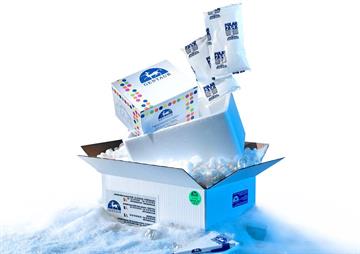Anti-Human Flt-3 Antibody

Anti-Human Flt-3 Antibody
748.5 EUR
In Stock
quantity
Produktdetaljer
Katalognummer: 209 - 101-M739
Produktkategori: Företag och industri > Vetenskap och laboratorium
ReliaTechGentaur
Storlek: 100 µg
Related Products
101-M419
Anti-Human Flt-3 Antibody
The Flt3 (fms-like tyrosine kinase) receptor, also named Flk2 (fetal liver kinase) and Stk1 (stem cell tyrosine kinase) is a member of the class III subfamily of receptor tyrosine kinases that also includes KIT, the receptor for SCF and FMS, the receptor for MCSF. The extracellular region of these receptors contains five immunoglobulin-like domains and the intracellular region contains a split kinase domain. Human Flt3 cDNA encodes a 993 amino acid (aa) residue type I membrane protein with a 26 aa residue signal peptide, a 515 aa extracellular domain with 10 potential N-linked glycosylation sites, a 21 aa residue transmembrane domain and a 431 aa residue cytoplasmic domain. Mouse Flt3 has also been cloned and shown to share 85% amino acid sequence identity with human Flt3. Flt3 expression has been detected in various tissues, including placenta, gonads, and tissues of nervous and hematopoietic origin. Among hematopoietic cells, the expression of Flt3 was found to be restricted to the highly enriched stem/progenitor cell populations. The ligand for Flt3 (FL) has been identified to be a transmembrane protein with structural homology to M-CSF and SCF. Recombinant soluble Flt3/ Fc chimeric protein has been shown to bind FL with high affinity and is a potent FL antagonist.
748.5 €
101-M739
Anti-Human Flt-3 Antibody
The Flt3 (fms-like tyrosine kinase) receptor, also named Flk2 (fetal liver kinase) and Stk1 (stem cell tyrosine kinase) is a member of the class III subfamily of receptor tyrosine kinases that also includes KIT, the receptor for SCF and FMS, the receptor for MCSF. The extracellular region of these receptors contains five immunoglobulin-like domains and the intracellular region contains a split kinase domain. Human Flt3 cDNA encodes a 993 amino acid (aa) residue type I membrane protein with a 26 aa residue signal peptide, a 515 aa extracellular domain with 10 potential N-linked glycosylation sites, a 21 aa residue transmembrane domain and a 431 aa residue cytoplasmic domain. Mouse Flt3 has also been cloned and shown to share 85% amino acid sequence identity with human Flt3. Flt3 expression has been detected in various tissues, including placenta, gonads, and tissues of nervous and hematopoietic origin. Among hematopoietic cells, the expression of Flt3 was found to be restricted to the highly enriched stem/progenitor cell populations. The ligand for Flt3 (FL) has been identified to be a transmembrane protein with structural homology to M-CSF and SCF. Recombinant soluble Flt3/ Fc chimeric protein has been shown to bind FL with high affinity and is a potent FL antagonist.
748.5 €
101-M420
Anti-Human Flt-3 Ligand Antibody
Flt-3 Ligand, also known as FL, is an α-helical cytokine that promotes the differentiation of multiple hematopoietic cell lineages. Mature human Flt-3 Ligand consists of a 158 amino acid (aa) extracellular domain (ECD) with a cytokine-like domain and a juxtamembrane region, a 21 aa transmembrane segment, and a 30 aa cytoplasmic tail. Within the ECD, human Flt-3 Ligand shares 71% and 65% aa sequence identity with mouse and rat Flt-3 Ligand, respectively. Human and mouse Flt-3 Ligand show cross-species activity. Flt-3 Ligand is expressed as a non-covalently linked dimer by T cells and bone marrow and thymic fibroblasts. Each 36 kDa chain carries approximately 12 kDa of N- and O-linked carbohydrates. Alternate splicing and proteolytic cleavage of the transmembrane form can generate a soluble 30 kDa fragment that includes the cytokine domain. Alternate splicing of human Flt -3 Ligand also generates membraneassociated isoforms that contain either a truncated cytoplasmic tail or an 85 aa substitution following the cytokine domain. Both transmembrane and soluble Flt-3 Ligand signal through the tyrosine kinase receptor Flt3/ FlK-1. Flt-3 Ligand induces the expansion of monocytes and immature dendritic cells as well as early B cell lineage differentiation.
748.5 €
Håll dig uppdaterad! Visa tidigare publikationer

By: Author , 2 Comment
Anaplasmos hos hundar och katter – allt du behöver veta
23 August 2025

By: Author , 2 Comment
Solbränna – hur leker man säkert i solen?
16 August 2025

By: Author , 2 Comment
Biologiska läkemedel – Modernitet inom farmaci
1 August 2025

By: Author , 2 Comment
Icke-steroida antiinflammatoriska läkemedel – viktig information om populära läkemedel
22 July 2025








